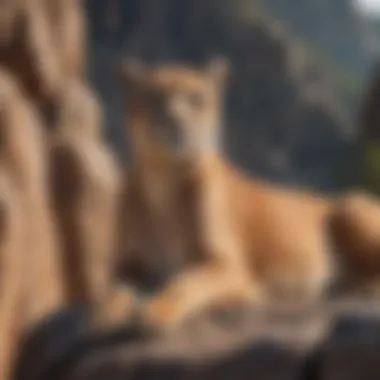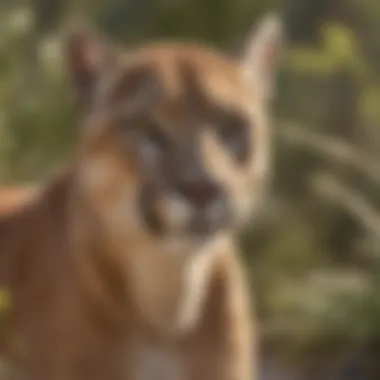Understanding the Puma: Insights into This Majestic Cat


Nature Topic Overview
Pumas, also known as cougars or mountain lions, are remarkable creatures. They belong to the Felidae family and are native to the Americas. Pumas are known for their agility, strength, and elusive nature. Understanding pumas can help us appreciate their role in ecosystems and recognize the challenges they face today. This overview will provide insight into their characteristics, habitats, diets, and behavior, laying the groundwork for a deeper exploration of these fascinating animals.
Fun Facts and Trivia
- Name Variations: The puma has many names. Some call it cougar, while others prefer mountain lion or panther.
- Large Range: Pumas have the largest range of any wild cat in the Western Hemisphere, covering areas from Canada to South America.
- Silent Hunters: Pumas often hunt alone and are known for their stealth. They can jump up to 40 feet in a single leap.
"The puma is more than just a powerful predator; it is a beautiful symbol of unspoiled nature."
Visuals like pictures of pumas in their habitats can help capture the interest of young readers. Incorporating interactive elements, such as quizzes about pumas' eating habits, can further enhance learning.
Wildlife Explorations
Pumas are not alone in their ecosystems. They share their habitats with many other species. For instance, deer are a primary food source. Understanding their prey is key to knowing pumas.
Other animals like bobcats and jaguars can be found in similar areas, and they all play crucial roles. Each species contributes to the balance of the ecosystem.
Kids can participate by taking part in wildlife exploration activities. For example, they can look for signs of animal life in their area, like tracks or fur.
Environmental Awareness
Conservation of pumas is vital. Their populations are threatened by habitat loss and human activities. Educating children about these issues is important. Simple actions can make a difference.
Some tips on how children can help:
- Educate Others: Talk about pumas and their importance to friends and family.
- Participate in Clean-ups: Join local nature clean-up events to keep habitats clean.
- Support Conservation Efforts: Learn about organizations working to protect wildlife.
DIY Nature Activities
Hands-on activities can inspire a love for nature. Here are some ideas:
- Puma Masks: Create masks using paper plates and colors to represent pumas and their unique features.
- Track Making: Use clay to make puma paw prints. This helps understand their size and shape.
- Outdoor Adventure: Go for a walk in a nearby park and identify plants or animals. Document findings in a nature journal.
By engaging with nature actively, children learn not just about pumas but also about the environment around them.
Prelude to the Puma
The puma, also known commonly as the cougar or mountain lion, plays an important role in ecosystems where it resides. Understanding this animal is crucial as it helps in appreciating biodiversity. Pumas not only maintain the balance of their habitats by controlling prey populations, but they also exemplify the wild spirit of North and South America. In this section, we will explore key aspects that define the puma, providing a solid foundation that will assist in the following sections.
Definition of a Puma
The puma is a large feline belonging to the Felidae family. Scientifically named Puma concolor, this species is notable for its adaptability across various landscapes. From icy mountains to dry deserts, pumas can thrive in diverse environments. They can reach a body length of up to eight feet from nose to tail. The definition highlights that pumas are solitary animals and they are primarily nocturnal, which means they are most active at night. Understanding its definition helps clarify the essential traits that make a puma unique in comparison to other carnivores.
Common Names and Synonyms
Pumas are known by several names across different regions. In North America, the term "cougar" is common, while the name "mountain lion" is often used in the western United States. In South America, particularly in the Andes, people often refer to them as "puma". Other synonyms include "catamount" and "panther," although the latter can refer to other large cats as well. This variety in names reflects the cultural significance and geographical diversity in which these magnificent creatures exist. Understanding these names fosters awareness of the puma's global presence and influence.
Taxonomy of the Puma
Taxonomy plays a crucial role in understanding the puma. It helps us categorize and identify this majestic creature within the animal kingdom. Knowing the taxonomy can enhance our appreciation for the puma's place in nature. It includes not just the classification, but also insights into its evolutionary relationships with other species.
Family and Genus Classification
The puma belongs to the Felidae family, which is quite significant. This family includes all types of cats, both big and small. The scientific name for the puma is Puma concolor. Understanding this classification helps in identifying its characteristics and behaviors that it shares with other members of the family. For instance, being part of the Felidae family means the puma is a carnivorous animal. This shared trait is fundamental to its role in the ecosystem.
Species Variants and Subspecies
Within the puma’s classification, various species and subspecies exist. The most recognized type is the North American cougar. Other types include the southern South American puma, which is slightly different in size and behavior. The differences can arise from geographical variations and environmental adaptations. These subspecies often have specific adaptations that help them to survive in their unique habitats. Some may have different fur patterns or sizes due to the environment they live in.
Overall, the taxonomy of the puma provides essential information that aids in conservation efforts. Understanding these distinctions helps to protect their diverse habitats and populations. This knowledge is vital for ensuring that future generations can continue to appreciate these remarkable animals.
Physical Characteristics


The physical characteristics of a puma are essential for understanding not only their biological needs but also their role in the ecosystem. These traits aid in their survival and hunting techniques. Learning about these characteristics will help children appreciate the complexities of wildlife. It’s important to note how these features contribute to their abilities as top predators.
Size and Weight
Pumas are large felines, with a notable range in size. They typically weigh anywhere from 64 to 220 pounds. Males are generally larger than females. Adult pumas can reach a length of about 3 to 5.25 feet, not including their tail, which can add an additional 26 to 34 inches. This size allows them to take down prey larger than themselves, such as deer. Their muscular build gives them strength and agility for hunting.
Fur and Coloration
The fur of a puma is quite distinctive. The base color is usually a tawny or light brown. This coloration helps them blend in with their surroundings, providing excellent camouflage in various habitats, from forests to mountains. The underbelly is generally lighter, often white or cream. As pumas mature, their fur may become a bit darker, especially on their back. Their fur also has a short, dense quality that helps them stay warm in colder climates. Additionally, pumas have black markings on their ears and the tip of their tail, which aids in communication with other pumas.
Distinctive Features
Pumas have several distinctive features that make them unique. Their large, rounded ears are quite noticeable and help them hear sounds from a distance. Their eyes are also striking; they are forward-facing, giving them excellent depth perception, particularly useful when hunting. Another feature is their powerful legs. Pumas can leap up to 40 feet in a single bound, which is vital for their hunting strategy. Their retractable claws and sharp teeth are essential tools for capturing and consuming their prey.
Pumas are remarkable hunters equipped with traits that enhance their survival in the wild.
The combination of size, fur, and distinctive features plays a crucial role in the puma's ability to thrive in diverse environments. By understanding these characteristics, readers can gain insights into the life of this extraordinary animal.
Habitat Preferences
Understanding the habitat preferences of the puma is crucial in comprehending how these animals interact with their environment. It helps us know where they thrive, which ecosystems they depend on, and what challenges they face in nature. By recognizing these elements, we can better advocate for their conservation and ensure their continued presence in the wild.
Geographical Range
Pumas are one of the most widely distributed big cats in the Americas. Their geographical range stretches from the western side of Canada, through the United States, and down to the southern tip of South America in Argentina and Chile. This expansive range is notable; pumas can adapt to various environments, including mountains, forests, deserts, and grasslands. They tend to avoid areas with heavy human presence, searching for places within their territory that provide adequate cover and abundant prey.
Fact: The puma's range covers around 2,000 miles, making it one of the most adaptable wild cats.
Preferred Ecosystems
Pumas show a preference for specific ecosystems. They are often found in mountainous regions, which provide ample hiding spots and vertical space for climbing and hunting. However, their adaptability allows them to inhabit other areas as well. Some common ecosystems where pumas thrive include:
- Forests: These dense areas offer excellent cover and access to various prey.
- Mountainous Regions: The rocky outcrops provide natural habitats and excellent vantage points for hunting.
- Grasslands: Open areas allow for stealthy approaches to prey while benefiting from fewer obstacles.
- Deserts: Although less common, some pumas have been known to navigate arid regions, adapting to the scarcity of water.
Overall, the puma's habitat needs revolve around the availability of prey, security from human disturbance, and environmental diversity. Recognizing these needs is vital in developing conservation strategies to protect their habitats and ensure a stable population of these magnificent animals.
Diet and Feeding Habits
Understanding the diet and feeding habits of the puma is essential to grasp how this animal survives in its natural environment. This topic sheds light on what sustains pumas and provides insight into their role in the ecosystem. Diet impacts growth, reproduction, and overall health. For young audiences, it’s crucial to understand that every animal plays a part in nature, and pumas are no different.
Primary Diet Composition
Pumas primarily consume a diet made up of ungulates, which are hooved animals. Common prey includes deer, such as the white-tailed deer and mule deer. This reliance on these animals is significant because it reflects the puma's role as both a predator and a prey manager in their ecosystem.
However, pumas are adaptable hunters. If their preferred choices aren't available, they can also take smaller mammals. These may include:
- Rabbits
- Rodents
- Birds
- Livestock in some cases, which can lead to conflicts with humans.
This flexibility in diet allows pumas to thrive in varied environments, from forests to mountains and even deserts.
Hunting Techniques
The hunting techniques of pumas are fascinating and showcase their agility and power. They are solitary hunters, usually stalking their prey quietly. Pumas rely on their excellent senses to identify potential meals. Their keen eyesight helps them spot movement, even at dusk or dawn when they are most active.
- Stalking:
Pumas often move stealthily, using the environment to hide. They may crouch low to the ground and slowly approach unsuspecting prey, ensuring that they remain unnoticed. - Pouncing:
Once close enough, pumas spring into action. They can leap several feet. Their powerful legs allow for a quick attack, which often results in a successful hunt. - Ambush:
In some cases, pumas will wait in trees or bushes for their prey to come near, then surprise them.
The skillful hunting techniques of the puma highlight its role as a top predator in its habitat.
After catching their prey, pumas often drag the animal to a secluded spot. This ensures safety from other predators.
Meal sharing and storing is common. Sometimes, pumas can consume up to 20 pounds of meat in a single sitting. However, they will cover and cache extra food for later.
Understanding these diet habits also reminds us of the delicate balance in nature. Each species, including the puma, contributes to the health of the ecosystem by controlling prey populations.
Behavioral Patterns
Understanding the behavioral patterns of pumas is essential to grasp their role in the ecosystem and their interaction with their environment. Pumas, also known as cougars or mountain lions, display a range of behaviors that are closely linked to their survival and reproduction. This section will dive into two critical aspects of puma behavior: social structure and territoriality.
Social Structure
Pumas are generally solitary animals. Unlike some big cats that form prides or groups, pumas prefer to live alone. Adult pumas usually have their own territories. The size of these territories can vary widely; it depends on factors like prey availability and habitat conditions. Male pumas often occupy larger areas compared to females. This arrangement helps reduce competition for resources.


The social interactions of pumas primarily occur during mating season. Male pumas may roam into the territories of females. If a female is receptive, they will engage in mating often over a few days. The strong emphasis on solitary behavior allows them to hunt more effectively without the need to compete with others.
Territoriality and Range
Territoriality is a significant part of a puma's behavior. Each puma patrols and marks their territory using scent markings. These markings may include urine or scratch marks left on trees and rocks. This behavior serves two main purposes: it establishes boundaries and deters other pumas from entering their area. In this way, pumas communicate their presence effectively.
A puma's range depends not only on their sex but also on resource availability.
- Male pumas: Their territories can cover hundreds of square miles, especially if they are trying to access several females.
- Female pumas: Their territories are smaller and focus on areas where they can find enough food and shelter for their young.
"Pumas are highly adaptable creatures, capable of thriving in diverse environments. Their territorial behavior is a key aspect of their ecological success."
Reproduction and Lifespan
Reproduction and lifespan are important topics when studying pumas. Understanding how pumas reproduce and how long they live gives insight into their role in ecosystems and their survival strategies. This helps in the conservation of pumas, especially as their populations face various threats.
Mating Season and Rituals
Pumas generally mate once a year. The mating season usually occurs during late winter to early spring. During this time, males will seek out females who are ready to mate, often traveling great distances to find them. This courtship involves various behaviors. Males may vocalize to attract females, using loud calls that echo in the forests. The male may also show off his strength and agility, performing leaps and chases to impress the female.
Once a female accepts a male, they will engage in a brief mating period lasting only a few days. This is essential for ensuring the continuation of the species. After mating, the couple goes their separate ways. It is typical for pumas to be solitary animals, as they prefer to hunt and live alone.
Gestation and Offspring
Gestation in pumas lasts about 90 to 96 days. During this time, the female prepares a safe den for her upcoming kittens. This den can be in a hidden spot, such as thick brush or caves, to protect her young from predators.
When the kittens are born, they usually number between one and six. They are blind and helpless at birth, relying fully on their mother for sustenance and protection. The mother feeds them with her milk, which is crucial for their growth. The kittens grow quickly and begin to open their eyes and explore their surroundings after a few weeks. They stay with their mother for around 1.5 to 2 years, during which they learn essential survival skills, such as hunting and navigating their territory.
Lifespan in the Wild vs. Captivity
The lifespan of pumas varies significantly between the wild and captivity. In the wild, pumas generally live up to 10 to 12 years due to factors like predation, disease, and food availability. In captivity, however, they can live much longer, often reaching ages of 15 to 20 years. This difference is mainly because captive pumas have consistent access to food and care, as well as reduced risks from predators.
Studies show that a stable environment can greatly enhance the health and longevity of wild animals.
Understanding these differences in lifespan highlights the challenges facing pumas in their natural habitats. Conservation efforts aim to create safer environments that can support the wild population, promoting not only their survival but also the entire ecosystem they inhabit.
Cultural Significance
The cultural significance of pumas is vast. These magnificent animals hold an esteemed place across various cultures, particularly in the Americas. Knowledge of their role extends beyond pure appreciation of their physical attributes. The image of the puma reflects traits such as strength, agility, and resilience, which has led to its representation in numerous cultural narratives and teachings.
Role in Indigenous Cultures
Indigenous communities often venerate the puma, viewing it as a symbol of power and spirit. Many tribal myths describe pumas as guardians or protectors. For instance, the Mapuche people of Chile regard the puma as a powerful presence in their mythology. This reverence impacts their relationship with the environment. Indigenous traditions emphasize respect for nature, which includes the puma as a vital part of the ecosystem.
The puma also plays a role in educational teachings within these cultures. Stories about the animal often encapsulate moral lessons. They teach children about the importance of balance in nature and the need to coexist peacefully. These narratives resonate with local beliefs and provoke admiration for wildlife.
Representation in Folklore and Media
The puma's influence can be seen in both folklore and modern media, illustrating its versatility as a cultural icon. In many Native American legends, the puma embodies courage and cleverness. These stories often highlight the animal's traits that humans aspire to have, such as bravery or cunning.
In contemporary times, pumas are frequently featured in films, books, and cartoons. They are depicted in various roles, from fearsome predators to wise and noble companions. For instance, animated films often incorporate pumas as characters that embark on adventures, serving to educate young viewers about the animal's ecological role while engaging their imaginations.
"The image of the puma serves dual purposes: a symbol of respect in tradition and a character of fascination in media, bridging the gap between reality and storytelling."
Thus, the representation of pumas across cultures enriches our understanding of them as more than mere wildlife. Instead, they symbolize broader themes of endurance and wisdom, fostering a connection between people, nature, and societal values.
Conservation Status
Conservation status is a critical aspect when discussing the future of the puma. Understanding its current standing helps assess the health of the species and the effective measures needed for its protection. The puma plays a significant role in maintaining the ecological balance. By protecting this animal, we also safeguard the entire ecosystem it inhabits.
Current Threats and Challenges
The puma faces numerous threats today. Habitat loss is one of the most pressing challenges, caused primarily by urban expansion and agriculture. As human populations grow, puma habitats are reduced. This leads to conflicts between humans and pumas, often resulting in the death of the animal.


Other threats include poaching and illegal hunting. Some people target pumas for their fur or to protect livestock. Additionally, environmental changes like climate change strain their habitats and food sources, making it harder for them to survive.
"The survival of the puma is not just about the species itself, but our entire planet's biodiversity."
Conservation Efforts and Strategies
Efforts to protect pumas are underway in various forms. Many organizations focus on habitat preservation by establishing wildlife reserves. These areas provide safe havens where pumas can roam and hunt without human interference.
Improving public awareness is also essential. Education campaigns help communities understand the importance of pumas. Learning about their role in nature encourages more people to participate in conservation efforts.
Moreover, initiatives like regulated hunting for population control are considered in some regions. This helps maintain a balance without pushing the species further into decline.
To summarize the conservation status of pumas, it is evident that without ongoing efforts, their future could be at risk. Protecting this majestic feline fosters a healthier environment for many species, including ourselves.
Common Misconceptions
Common misconceptions about pumas often stem from misunderstandings about their behavior, habitat, and characteristics. These myths can affect not only the perception of the animal but also its conservation. It is essential to address these misconceptions to provide a clearer understanding of pumas, ensuring that people recognize their value in the ecosystem and the importance of protecting them.
Myths Surrounding the Puma
- Pumas are aggressive man-eaters.
Many people believe that pumas pose a significant threat to human safety. In reality, pumas usually avoid humans and prefer to hunt smaller prey, such as deer. Attacks on humans are extremely rare. - Pumas are the same as cougars or mountain lions.
This is partially true as "puma," "cougar," and "mountain lion" are different names for the same species. However, some people mistakenly think these are distinct animals. They are indeed the same animal, but the common name varies by region. - Pumas are found in cold climates only.
While some pumas inhabit colder areas, they are versatile and adapt to varied environments, from tropical forests to deserts, demonstrating significant flexibility in habitat preferences.
Clarifying Facts
It is important to clarify these notions, as understanding the true nature of pumas can lead to a better appreciation and protection of this species.
- Behavior: Pumas are solitary animals with a strong territorial instinct. They prefer to live alone except during mating or when a mother is caring for her cubs.
- Diet: As carnivores, their diet primarily consists of ungulates. They can hunt animals much larger than themselves, proving their strength and agility.
- Population Status: Pumas are not endangered; however, they face various threats, mainly due to habitat loss and hunting. Conservation efforts are vital for their long-term survival.
Understanding these facts allows us to respect pumas as important environmental members rather than viewing them through a lens of fear and misunderstanding.
Pumas in Pop Culture
Pumas have a significant presence in popular culture. Their image often evokes strength, agility, and mystery. This section discusses how pumas are portrayed in different forms of media and acknowledges their use in branding. The way pumas are depicted can greatly influence public perception and understanding of this majestic animal.
Portrayals in Literature and Film
In literature, pumas often represent both beauty and danger. Stories may include these animals as heroic figures or formidable antagonists. A classic example is found in adventure novels set in the wilderness, where pumas embody the spirit of the untamed.
Films also showcase pumas in various roles. For instance, animated movies frequently present them as wise or cunning characters, appealing to younger audiences. One notable film is "The Jungle Book," where the character of Bagheera is a panther representing intelligence and protection. While Bagheera is not a puma, he embodies similar feline traits that capture the essence of big cats.
Additionally, documentaries about wildlife often highlight the puma's behavior and role in the ecosystem, educating viewers about their natural habitat and lifestyle. These portrayals can indeed foster a greater appreciation for the animal.
Uses in Branding and Mascots
The puma's fierce yet elegant image makes it a popular choice for branding and mascots. Many sports teams and clothing brands adopt the puma as a mascot. The Puma SE brand, for example, is recognized worldwide for its sportswear and footwear, drawing inspiration from the animal's agility and speed.
In advertising, pumas symbolize performance and excellence. Companies often utilize their image to convey strength and reliability. This marketing approach can inadvertently affect public perceptions about real pumas, emphasizing their power while overlooking their vulnerability in the wild.
Important Note: Brands leveraging the puma image help generate interest in wildlife conservation. When people admire pumas through branding and media, they may become more inclined to learn about their natural behavior and environment, leading to increased awareness about their conservation status.
Overall, pumas in pop culture serve to shape perceptions of these fascinating felines, impacting the public’s approach towards conservation and respect for wildlife.
Ending
In this article, we have explored the fascinating world of pumas, offering a comprehensive guide that highlights several key aspects of this remarkable feline. As we conclude our journey, it is crucial to recap the primary elements that contribute to understanding the significance of pumas in their ecosystems and their role in our world. Through an examination of their physical traits, habitat preferences, and diet, we have built a strong picture of this animal that is often misunderstood.
The importance of this conclusion lies in how it synthesizes all the information presented throughout the article. By connecting the dots between aspects like the puma’s social structure and its behavioral patterns, we emphasize how these elements contribute to its survival. In recognizing the various challenges pumas face, such as habitat loss and human encroachment, we move toward the second vital part of this conclusion: understanding the role we all play in their conservation.
Summary of Key Points
- Pumas, also known as mountain lions, possess unique physical characteristics that aid them in their natural environments.
- Their habitat ranges across diverse ecosystems, showing adaptability and resilience.
- The puma's diet primarily consists of large mammals, which they hunt using specific techniques that highlight their predatory skills.
- Understanding puma behavior, such as territoriality and social structures, is essential for appreciating their role as apex predators.
- Conservation efforts are necessary to ensure the survival of pumas in increasingly fragmented habitats.
Importance of Environmental Awareness
Environmental awareness is crucial for the continued existence of pumas and other wildlife. Young readers, parents, teachers, and caregivers play a key role in building a future where such species can thrive. By understanding our impact on the environment, including pollution and habitat destruction, we can take appropriate action to protect these animals.
Supporting conservation initiatives, advocating for sustainable practices, and educating others about puma habitats can make a significant difference. Simple actions can lead to larger changes, and every positive step taken toward environmental preservation supports the delicate balance of ecosystems where pumas live.
The puma symbolizes the beauty and challenges faced by many wildlife species today. Recognizing their importance can inspire proactive measures toward a healthier planet.
"By preserving pumas, we also preserve the integrity of their habitats, ensuring that future generations can experience the wonder of nature."







